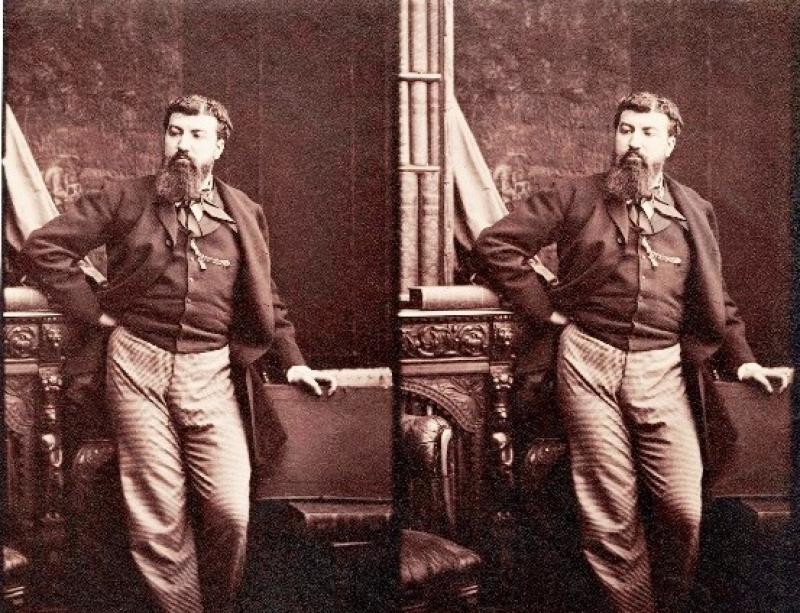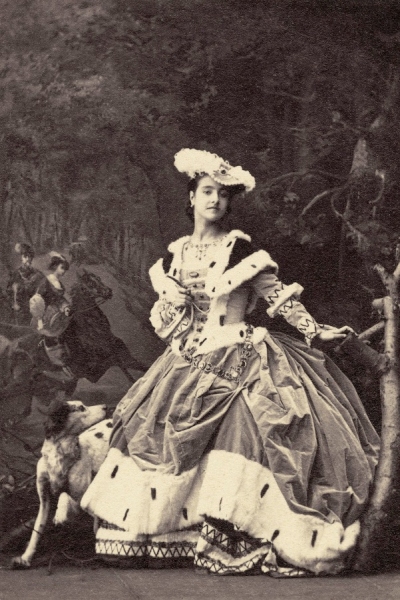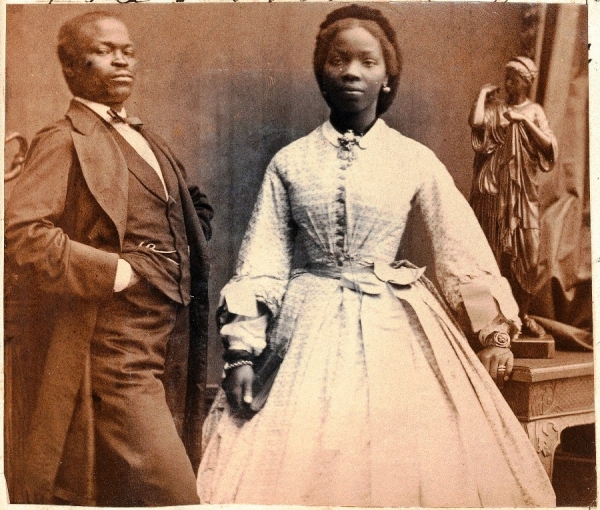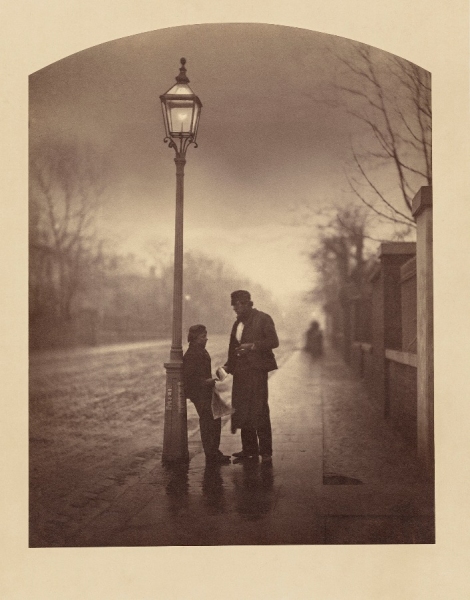Camille Silvy: Photographer of Modern Life, 1834-1910, National Portrait Gallery | reviews, news & interviews
Camille Silvy: Photographer of Modern Life, 1834-1910, National Portrait Gallery
Camille Silvy: Photographer of Modern Life, 1834-1910, National Portrait Gallery
Portrait photographer to Victorian society has his first exhibition in a century

Camille Silvy may be the least recognised of all the great photographic innovators of the 19th century. After a decade of almost ceaseless technical innovation, and astonishing output as the society portrait-photographer of the 1860s, he abruptly closed his London studio, aged only 34, returned to France, and, after a brief stint in the garde mobile in the Franco-Prussian War, spent much of the rest of his life in and out of asylums.
Silvy was said to have given up a burgeoning diplomatic career for this new profession of photographer, but it must have been a career barely beginning to bud, for in 1858, aged only 22, he had already produced one of the works that won him renown, Valée de l’Huisne, a carefully staged landscape in which multiple images were merged, clouds from one negative transferred to another, the foreground "burnt in" afterwards, different exposures used, people carefully posed on the riverbank. Indeed, Silvy was more director than photographer, as the camera itself was "operated" by another. His follow-up, Trophées de la chasse of the same year, is also a remarkable simulacrum of a traditional still-life.
 These images brought him recognition and praise in France, but the following year Silvy abruptly changed tack, decamping to London and setting up a studio in Bayswater in London that specialised in the newest vogue – the carte-de-visite, or portrait card. Silvy was a shrewd tactician, and he began by photographing actors, singers and other performers – there is a wonderfully light, bright image of the comedian Frederick Robson, halfway out of a door, his hat and elbow jauntily leaving the room. More traditional was his long photographic relationship with the opera star Adelina Patti (pictured above, in costume for the popular opera Martha, by Flotow). These images were used for promotional purposes by the sitters, but they were also collected by the public, thus promoting Silvy's name every time one was sold.
These images brought him recognition and praise in France, but the following year Silvy abruptly changed tack, decamping to London and setting up a studio in Bayswater in London that specialised in the newest vogue – the carte-de-visite, or portrait card. Silvy was a shrewd tactician, and he began by photographing actors, singers and other performers – there is a wonderfully light, bright image of the comedian Frederick Robson, halfway out of a door, his hat and elbow jauntily leaving the room. More traditional was his long photographic relationship with the opera star Adelina Patti (pictured above, in costume for the popular opera Martha, by Flotow). These images were used for promotional purposes by the sitters, but they were also collected by the public, thus promoting Silvy's name every time one was sold.
High society swiftly followed the stars, and Silvy was soon running a "factory" that would have put Andy Warhol’s similar art-workshop to shame: 40 people operated behind the scenes, while Silvy, always impeccably white-gloved, himself posed the sitters in his grand studio.
 The sitters ranged from society couples (Silvy reached the apogee of society, photographing Prince Albert himself), to Queen Victoria’s black goddaughter, Sarah Forbes Bonetta (pictured right, with her husband), and even the today macabre-seeming practice of memorialising dead children in posthumous photographs. Silvy’s eye was remarkable, and what might in other hands have been routine poses, in his work come alive. The Misses Booth, two sisters, are posed with one facing the camera, the other beside her with her back turned. In a mirror between them, her face is captured and reflected back at the viewer, creating a triad of enlaced heads that would have pleased Van Dyck. The Misses Marjoribanks are less elaborately posed. Instead, their remarkable dresses speak for them, as the violent horizontal stripes across the crinolines are carefully arranged to create a single slashing line across the picture surface.
The sitters ranged from society couples (Silvy reached the apogee of society, photographing Prince Albert himself), to Queen Victoria’s black goddaughter, Sarah Forbes Bonetta (pictured right, with her husband), and even the today macabre-seeming practice of memorialising dead children in posthumous photographs. Silvy’s eye was remarkable, and what might in other hands have been routine poses, in his work come alive. The Misses Booth, two sisters, are posed with one facing the camera, the other beside her with her back turned. In a mirror between them, her face is captured and reflected back at the viewer, creating a triad of enlaced heads that would have pleased Van Dyck. The Misses Marjoribanks are less elaborately posed. Instead, their remarkable dresses speak for them, as the violent horizontal stripes across the crinolines are carefully arranged to create a single slashing line across the picture surface.
As well as these paying propositions, Silvy continued to experiment with the camera, promoting the reproduction of art, and creating some remarkable images of his own – Twilight (pictured below), photographed outside his Bayswater studio is, as with his early landscapes, in reality four different images combined. Yet it is this image, and its technique, that points up the oddity of the exhibition’s title. "Photographer of Modern Life" is Baudelaire’s description of the flâneur, that lounger-about-town who is both the recorder and the subject of modern life. Yet a flâneur is the very last thing that Silvy either was or recorded. The evanescent, fleeting, fugitive quality of modern life, the participant as artist, were what concerned Baudelaire, while Silvy harked back to an older tradition of craft and technique, of laboriously contrived 'reality', and of artist as observer.
 Similarly, while the NPG has been admirably purist about showing original prints, the style of the period does work against a comfortable viewing experience today. Most of the images are tiny – the standard size for portraits is less than 90mm high – and the details that can be easily seen in larger reproductions, or even on screen, are almost invisible in the gallery. Thus Silvy’s art photography, which tends to be larger, is more accessible than the many dozens of portraits, which are almost better seen in Mark Haworth-Booth’s admirable catalogue that goes with the show.
Similarly, while the NPG has been admirably purist about showing original prints, the style of the period does work against a comfortable viewing experience today. Most of the images are tiny – the standard size for portraits is less than 90mm high – and the details that can be easily seen in larger reproductions, or even on screen, are almost invisible in the gallery. Thus Silvy’s art photography, which tends to be larger, is more accessible than the many dozens of portraits, which are almost better seen in Mark Haworth-Booth’s admirable catalogue that goes with the show.
Still, on the page or on the wall, it is good to have this extraordinary pioneer back with us, with this first exhibition in more than a century.
- Camille Silvy: Photographer of Modern Life 1834-1910 is at the National Portrait Gallery, London WC2 until 24 October
- Find Mark Haworth-Booth's work on Amazon
Share this article
Add comment
The future of Arts Journalism
You can stop theartsdesk.com closing!
We urgently need financing to survive. Our fundraising drive has thus far raised £49,000 but we need to reach £100,000 or we will be forced to close. Please contribute here: https://gofund.me/c3f6033d
And if you can forward this information to anyone who might assist, we’d be grateful.

Subscribe to theartsdesk.com
Thank you for continuing to read our work on theartsdesk.com. For unlimited access to every article in its entirety, including our archive of more than 15,000 pieces, we're asking for £5 per month or £40 per year. We feel it's a very good deal, and hope you do too.
To take a subscription now simply click here.
And if you're looking for that extra gift for a friend or family member, why not treat them to a theartsdesk.com gift subscription?
more Visual arts
 'We are bowled over!' Thank you for your messages of love and support
Much-appreciated words of commendation from readers and the cultural community
'We are bowled over!' Thank you for your messages of love and support
Much-appreciated words of commendation from readers and the cultural community
 Lee Miller, Tate Britain review - an extraordinary career that remains an enigma
Fashion photographer, artist or war reporter; will the real Lee Miller please step forward?
Lee Miller, Tate Britain review - an extraordinary career that remains an enigma
Fashion photographer, artist or war reporter; will the real Lee Miller please step forward?
 Kerry James Marshall: The Histories, Royal Academy review - a triumphant celebration of blackness
Room after room of glorious paintings
Kerry James Marshall: The Histories, Royal Academy review - a triumphant celebration of blackness
Room after room of glorious paintings
 Folkestone Triennial 2025 - landscape, seascape, art lovers' escape
Locally rooted festival brings home many but not all global concerns
Folkestone Triennial 2025 - landscape, seascape, art lovers' escape
Locally rooted festival brings home many but not all global concerns
 Sir Brian Clarke (1953-2025) - a personal tribute
Remembering an artist with a gift for the transcendent
Sir Brian Clarke (1953-2025) - a personal tribute
Remembering an artist with a gift for the transcendent
 Emily Kam Kngwarray, Tate Modern review - glimpses of another world
Pictures that are an affirmation of belonging
Emily Kam Kngwarray, Tate Modern review - glimpses of another world
Pictures that are an affirmation of belonging
 Kiefer / Van Gogh, Royal Academy review - a pairing of opposites
Small scale intensity meets large scale melodrama
Kiefer / Van Gogh, Royal Academy review - a pairing of opposites
Small scale intensity meets large scale melodrama
 Jenny Saville: The Anatomy of Painting, National Portrait Gallery review - a protégé losing her way
A brilliant painter in search of a worthwhile subject
Jenny Saville: The Anatomy of Painting, National Portrait Gallery review - a protégé losing her way
A brilliant painter in search of a worthwhile subject
 Abstract Erotic, Courtauld Gallery review - sculpture that is sensuous, funny and subversive
Testing the boundaries of good taste, and winning
Abstract Erotic, Courtauld Gallery review - sculpture that is sensuous, funny and subversive
Testing the boundaries of good taste, and winning
 Edward Burra, Tate Britain review - watercolour made mainstream
Social satire with a nasty bite
Edward Burra, Tate Britain review - watercolour made mainstream
Social satire with a nasty bite
 Ithell Colquhoun, Tate Britain review - revelations of a weird and wonderful world
Emanations from the unconscious
Ithell Colquhoun, Tate Britain review - revelations of a weird and wonderful world
Emanations from the unconscious
 Rachel Jones: Gated Canyons, Dulwich Picture Gallery review - teeth with a real bite
Mouths have never looked so good
Rachel Jones: Gated Canyons, Dulwich Picture Gallery review - teeth with a real bite
Mouths have never looked so good

Comments
...